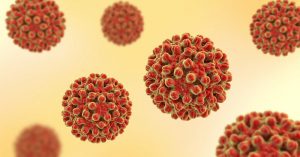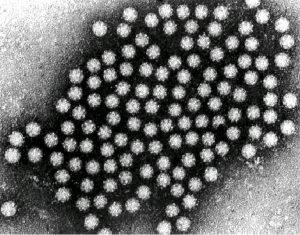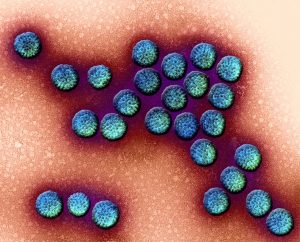1) Noroviruses

>
Common name of illness
- Variously called viral gastroenteritis
Onset time after ingesting
- 12-48 hrs
Sources
- Raw produce
- contaminated drinking water
- uncooked foods and cooked foods that are not reheated after contact with an infected food handler
- shellfish from contaminated waters
Sign & Symptom
- winter diarrhea
- acute non- bacterial gastroenteritis
- nausea
- vomiting
- abdominal cramp
- diarrhea
- fever
- headache.
[collapse]
2) Hepatitis A

>
Common name of illness
- Hepatitis
Onset time after ingestion
- 15-50 days (28 days average)
Sign & Symptom
- Diarrhea
- dark urine
- jaundice
- flu-like symptoms (fever, headache, nausea, and abdominal pain)
Sources
- Contaminated drinking water
- shellfish from contaminated waters
- frozen berries.
[collapse]
3) Astrovirus

>
Astroviruses are small, nonenveloped, single-stranded, positive sense RNA viruses that cause asymptomatic infections
Common name of illness
known to cause enteric disease in mammals and birds.
Sign & Symptom
- Leading cause of childhood diarrhea
- fatal duckling hepatitis
Sources
- Widespread in poultry
- Oysters
- shellfish
Who’s at risk
- Primarily affects children
- elderly
- immunocompromised people.
Transmission
- fecal/oral
- fomites
- contaminated food and water.
[collapse]
4) Rotavirus

>
Rotavirus is a virus that infects the bowels, causing a severe inflammation of the stomach and bowels (gastroenteritis)
Sign & Symptom
- Fever
- Vomit
- Watery diarrhea
- Abdominal pain
- Lethargy
- Dry or sticky mouth
- Extreme thirst.
Who’s at risk
- Infants and children are most commonly infected with rotavirus.
- Adults may also become infected, but the resulting illness is usually less severe than that in infants and young children.
Source
- Virus shed in stool in large numbers
Transmission
- Fecal-oral route, children can transmit the virus when they forget to wash their hands before eating or after using the toilet.
- Touching a surface that has been contaminated with rotavirus and then touching the mouth area can result in infection.
[collapse]
